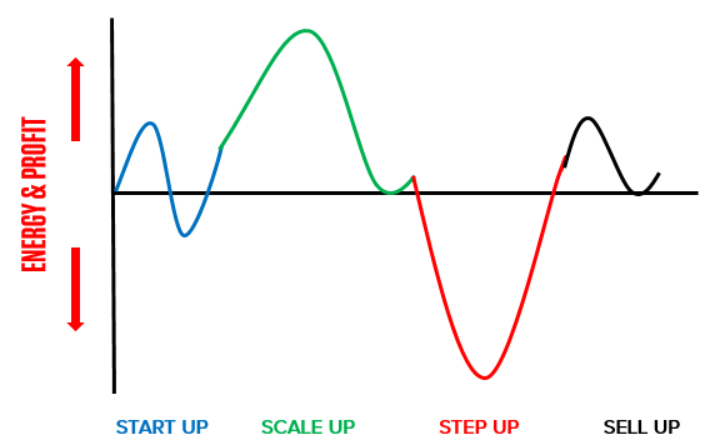
Understanding Business Life Cycle
by Jacob Aldridge, International Business Advisor
I have the privilege to speak at a number of conferences around Australia, and even some internationally. I find that this specific topic resonates best – maybe it’s all the Conference or Networking junkies suddenly realising that they’re running their business … not copying somebody else’s?
Stop me if you’ve heard this one before: you read a great case study on a website, saw an experience entrepreneur speak, or took notes at your networking forum … went back into your business and implemented exactly what they did … and it was a complete fizzer, or worse.
Sorry kid, like the poetry major handing in math equations on his midterms, you copied the wrong homework. Let me show you how this happens, so you won’t make the same mistake again.
The Lifecycle of Business
Every business goes through the same lifecycle – big or small, fast or slow, the journey is the same. How fast we move through may differ. And many – in fact, most – businesses don’t survive the whole journey. For those that do, it’s an emotional rollercoaster with speedbumps, hurdles and brick walls to navigate.
To help us understand – and therefore apply – this emotional journey better, at business DEPOT we’ve broken it up into four separate cycles – Start Up, Scale Up, Step Up (when energy and profit sags), and Sell Up (when you choose to exit on your terms or go around again).

Within each of those smaller cycles, you can see a smaller journey – each of them can be broken into 3 distinct phases, investment, return on investment, and the phase when that investment has run its course.
As a business owner, you and your business are somewhere on this journey. And every other business owner you talk to, listen to, or learn from is also somewhere on this journey.
But if they’re not in the same place you are, then what works for them probably won’t work for you!
Why Most Conference Speakers Won’t Help You
Let me give you the most common example, and it’s the difference between the Start Up (in Blue when you need to focus on Revenue) and Scale Up (in Green when you need to focus on Growth).
Most great business stories you hear are told by business owners in the Green – they’re growing fast, feeling relaxed, and their business is nicely profitable.
My team run several dozen events each year, and like you (even more now that so many are virtual) I attend many more. ow likely are you to go listen to a speaker who currently feels stuck in their business, is losing money, and is wondering whether this is all still worth it?
Of course not, so these entrepreneurs never tell their story, and if your business is in one of those brick walls you’ll walk away from every event thinking ‘what am I doing so wrong?’.
Trust me, it’s not you – it’s them!
They tell you things like “invest in marketing”, “take Fridays off”, and “delegate responsibility to your team”. Great advice, when you’ve established your business model and are scaling it up.
Terrible advice in Start Up. If you’re before them on the lifecycle, you need to do things that don’t scale – like working long hours, doing almost everything yourself, and squeezing in as much sales activity as you can muster.
If you don’t, you’ll join the 50% of Australian businesses that fail in the first 3 years – they never make it to Green … in many cases, because they copied the wrong homework and acted like a Scale Up business before they were ready.
Similarly, it’s the wrong lesson to learn if you’re in a Step Up business and feeling stuck, stressed, and desperate. You remember the good old days when everything was as easy as the guy on stage is making out … but things changed, and you need something different to ‘what used to work’.
Because if you try going back in time, acting as-if the last five or so years of your business hadn’t happened, then like a new business trying to grow too fast … you’ll be copying the wrong homework.
So is Coaching or Mentoring the solution?
Well maybe … or maybe not. This is also where Mentoring can be excellent or disastrous. A great mentor has walked your path before – they can say ‘Ah, when I was at your stage I did these 3 things to make a difference’.
As long as your industry hasn’t changed all that much, a big if I might add, then you’ve got great advice.
Bad mentors say ‘Here’s what I’m doing now’ without consideration for your businesses being at a different point.
Great mentors and coaches know that understanding where in the business lifecycle you are right now is a critical first step to being able to help empower your bright ideas.
Actions
- Know where your business is in its lifecycle
I can – and have – run conferences over several days that ONLY focus on the detail of the Business Lifecycle framework. Despite the detail, it can be easy to understand – you can start by watching the first few episodes of my YouTube playlist
- Identify where other business owners are in their journey
How are they feeling? What are their challenges? What does this mean for their relationship with you – as a customer, prospect, mentor, etc?
- Learn when to copy … and when to keep the notes for next semester
Implement the great ideas that are right for you, and don’t waste time on those you don’t need yet
In coming months we will explore the more emotional aspect of how the business lifecycle impact your feelings and communication as a leader. My next book, speaking specifically to Visionary Male Leaders on the importance of Embracing Feminine Energy in Business is also due for release in October 2021 – so I will see you then!



